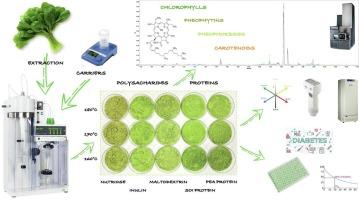Polysaccharide- and protein-based carriers as a key strategy for obtaining microencapsulated chlorophyll-rich extracts: UPLC-PDA/ESI-QToF-MS characterization and evaluation of antidiabetic potential
IF 9.8
1区 农林科学
Q1 CHEMISTRY, APPLIED
引用次数: 0
Abstract
Chlorophylls are bioactive compounds with potential health benefits. This study aimed to investigate the physicochemical properties and biological activity of chlorophyll-rich microcapsules, focusing on the influence of carrier type and spray drying temperature on chlorophyll stability and enzyme inhibition capacity. The research hypothesis assumed that these factors significantly affect both the retention of bioactive compounds and the health-promoting properties of the microcapsules, particularly their ability to inhibit enzymes involved in type 2 diabetes. Microcapsules were prepared using various polysaccharide (Nutriose®, inulin, maltodextrin) and protein (soy and pea protein isolates) carriers and three inlet temperatures (160, 170, 180 °C). Compounds including carotenoids, chlorophylls, pheophytins, and pheophorbides were identified and quantified via UPLC-PDA/ESI-QToF-MS. The antidiabetic potential was evaluated by in vitro inhibition of α-amylase, α-glucosidase, β-glucosidase, and dipeptidyl peptidase-4 (DPP-4). Carrier selection had a greater impact than drying temperature, with soy protein isolate and inulin ensuring the highest chlorophyll retention and stability. Protein-based microcapsules showed the strongest DPP-4 and α-amylase inhibition, indicating potential for glycemic control. These findings advance microencapsulation strategies for chlorophyll-rich extracts in functional food and pharmaceutical applications.


多糖和蛋白质载体作为获得富含叶绿素微胶囊提取物的关键策略:UPLC-PDA/ESI-QToF-MS表征和降糖潜力评价
叶绿素是具有潜在健康益处的生物活性化合物。本研究旨在研究富叶绿素微胶囊的理化性质和生物活性,重点研究载体类型和喷雾干燥温度对叶绿素稳定性和酶抑制能力的影响。该研究假设,这些因素显著影响了微胶囊的生物活性化合物的保留和促进健康的特性,特别是它们抑制2型糖尿病相关酶的能力。采用不同的多糖(Nutriose、菊粉、麦芽糊精)和蛋白质(大豆和豌豆分离蛋白)为载体,在三种进口温度(160、170、180 °C)下制备微胶囊。通过UPLC-PDA/ESI-QToF-MS对类胡萝卜素、叶绿素、叶绿素和含磷化合物进行了鉴定和定量。通过体外抑制α-淀粉酶、α-葡萄糖苷酶、β-葡萄糖苷酶和二肽基肽酶-4 (DPP-4)来评价其抗糖尿病潜能。载体选择比干燥温度的影响更大,大豆分离蛋白和菊粉保证了最高的叶绿素保留率和稳定性。蛋白基微胶囊对DPP-4和α-淀粉酶的抑制作用最强,表明其具有控制血糖的潜力。这些发现促进了富含叶绿素提取物在功能性食品和药物应用中的微胶囊化策略。
本文章由计算机程序翻译,如有差异,请以英文原文为准。
求助全文
约1分钟内获得全文
求助全文
来源期刊

Food Chemistry
工程技术-食品科技
CiteScore
16.30
自引率
10.20%
发文量
3130
审稿时长
122 days
期刊介绍:
Food Chemistry publishes original research papers dealing with the advancement of the chemistry and biochemistry of foods or the analytical methods/ approach used. All papers should focus on the novelty of the research carried out.
 求助内容:
求助内容: 应助结果提醒方式:
应助结果提醒方式:


